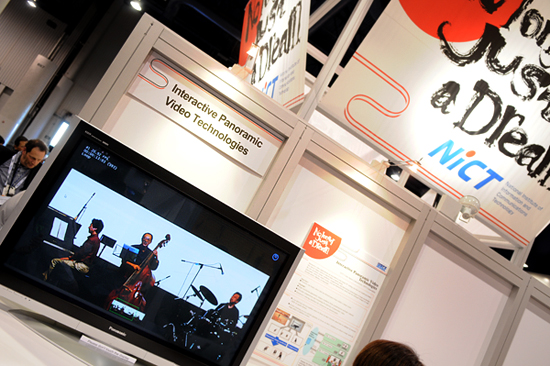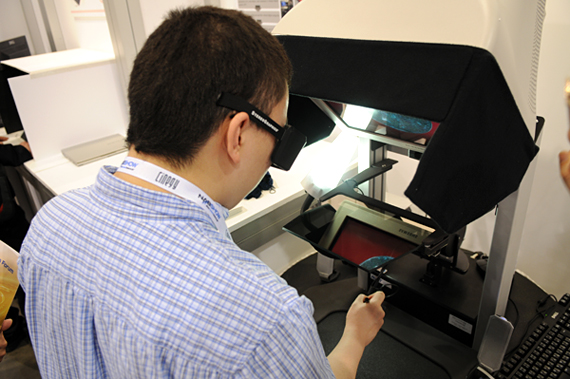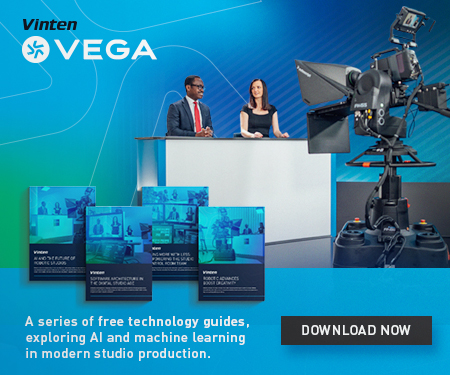Unique 3D technologies add food for thought
Subscribe to NewscastStudio for the latest news, project case studies and product announcements in broadcast technology, creative design and engineering delivered to your inbox.

The Interactive Panoramic Video Technology sits on display at the National Institute of Information and Communications Technology. Photo: Dak Dillon/NewscastStudio
3D seems to be one of the buzz words at this year’s NAB Show.
The National Institute of Information and Communications Technology had some innovative 3D-based technologies on display and made available to the press during a pre-show tour.
The Japanese-based organization works to advance communications technologies and conducts its own research and contributes to national policy in related areas.
Not all of the technology on display had practical applications for TV news, but they have some interesting features that we thought we’d share with our readers and also provide some thought-provoking applications and points to consider.
The first area NewscastStudio explored was a dark walk-through room that provided a demonstration of a 3D video display that does not require glasses. The display was a bit blurry and, when viewed from the far left and right side of the room, didn’t retain the full 3D effect.
However, the effect was comparable to the 3D movie experiences found at amusement parks. It was interesting that the display did not require the use of glasses, which are an inconvenient yet necessary-evil part of 3D video. At this point, there isn’t an application for this type of technology in TV news since it requires special technology for the end-user and production team.
However, it will be interesting to see how, if at all, 3D technology will filter into TV news. One of the biggest roadblocks is, of course, the requirement for the end-user to have compatible equipment since one can’t realistically expect people to wear 3D glasses to watch the news every night. Should 3D display work its way into TV news, it seems more likely that it would used in computer-generated graphic applications rather than of talent. Talent imagery would feel more gimmicky while applications such as 3D maps, charts and graphs could add some additional layers to storytelling.
Our next stop was a fascinating application of 3D technology that allows the user to not only see the object but feel and interact with it. By using a monitor and mirror setup and pair of 3D glasses, the user holds a pencil-like apparatus that’s mounted beneath the mirror’s surface.

Michael P. Hill, NewscastStudio founder and publisher, manipulates the NICT demonstration on Sunday. Photo: Dak Dillon/NewscastStudio
As you manipulate the pencil one sees a computer generated stylus that can touch the image of an ornamental disc. As the virtual pencil glides over of the surface, the mechanical apparatus adds the appropriate tension and to create the feel that you’re actually running the pencil over a physical object. Sound effects add to the realism. The pencil could also be used to grab the edge of the disc and flip it. The level of tension was even different on rough vs. smooth surfaces. This technology probably doesn’t have any real applications for news, though it was fascinating to try (it’s billed as having medical training applications as well as for virtual product shopping and demonstrations).
One demo that could be used in news, however, was a lossless panoramic technology. Using a video stream of a concert controlled by a Wii remote (similar to Beat the Traffic’s use of the game system’s controller), one can pan, tilt and zoom around the image with little loss in picture quality.
This technology could be very useful in covering highly-visual stories that require a broad view as well as close-ups.
Next to this technology were super-high resolution HD monitors that were run by computers. This too could have some applications for TV news as HD broadcasts become more prevalent. One of the biggest challenges of using on-set monitors to display graphics and interactive content is how well the quality translates when shot with a camera under bright studio lights. Though we weren’t able to experiment with how the monitors would look on-camera, the picture quality was outstanding even under the convention floor’s harsh bright lighting.
The final demonstration moved away from 3D video and instead focused on 3D audio. Using multiple sphere-shaped speaker units as well as more traditional brick-style, a small room in the booth was able to replicate not only the sound but the position of the various instruments in a musical group.
Moving around the room provided subtle yet interesting shifts in how each instrument sounded in relation to the others. Here again, there probably isn’t much use for this technology in TV news, but it does make a point of an area TV news could explore further: how to make audio more engaging as more advanced sound technologies become more prevalent. Although TV is dominated by picture quality, there is much to be said about the storytelling value of audio. Organizations such as NPR use audio to their advantage to place listeners into the scene by combining the visual descriptions of the reporters with the visual imagery conjured by sound.
Subscribe to NewscastStudio for the latest news, project case studies and product announcements in broadcast technology, creative design and engineering delivered to your inbox.



tags
3D, Audio, video
categories
NAB Show